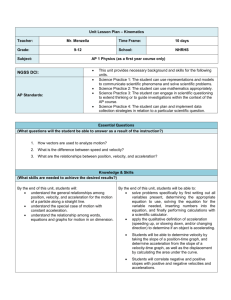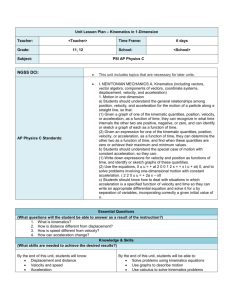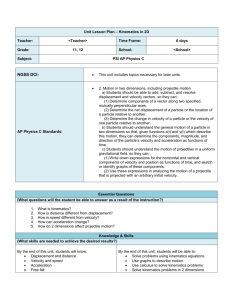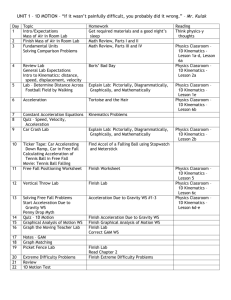Speed
advertisement
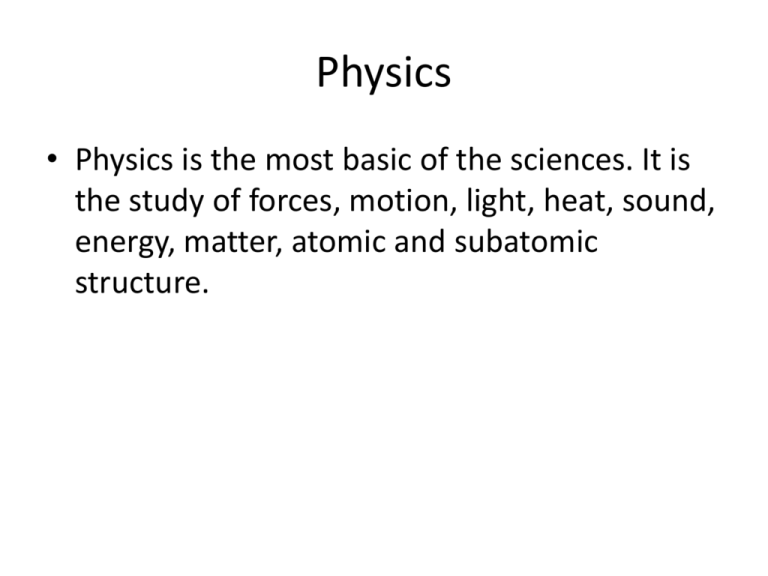
Physics • Physics is the most basic of the sciences. It is the study of forces, motion, light, heat, sound, energy, matter, atomic and subatomic structure. Kinematics • Kinematics is the branch of physics that describes the motion of points, bodies (objects), and systems of bodies (groups of objects) without consideration of the causes of motion. Kinematics • Relative motion - All motion is relative. Right now we appear to be motionless relative to each other. Kinematics • If an observer from space were to look at us, he would realize that we actually are in motion. Kinematics • We are moving because we are on the earth which is rotating. Kinematics • The earth is also moving around the sun. The sun is moving through the Milky Way, and so on. Kinematics • We appear to be motionless relative to each other, because we are moving together. We say that we are in the same frame of reference. Kinematics • In this course we will be talking only about motion of objects relative to the surface of the earth unless otherwise stated. Kinematics • Speed is a measure of how fast something is moving . It is measured in terms of a unit of distance divided by a unit of time. Examples are: m • meters per second s mi • miles per hour h km • kilometers per hour h • The word “per” means “divided by”. Kinematics • Instantaneous speed is a speed at any given instant. It is the speed read by the speedometer in your car. • Average speed is the total distance covered divided by the time interval required to cover that distance. total distance covered average speed = time interval Kinematics • Example: You travel a distance of 100 miles during the time interval of two hours. What is your average speed? total distance covered average speed = time interval 100mi 50mi average speed = = 2h h Kinematics • Notice how the units follow the numbers in the calculations. • The units are treated like the letters in algebra. Kinematics • In physics speed and velocity mean two different things. • Velocity means speed in a given direction. • If we say a car is moving at we are talking about speed. Speed is a scalar quantity. It is characterized only by magnitude. • If we say a car is moving at north we are talking about velocity. Velocity is a vector quantity. It is characterized by magnitude and direction. 60 km h 60 km h Kinematics • In order for an object to be moving with constant velocity its speed must be constant, and its direction must also be constant. • If either the speed and direction of a moving object is changing, or if both are changing, then it's moving with changing velocity. Kinematics Acceleration • Acceleration is defined as change in velocity per time interval change in velocity aceleration = time interval Kinematics Acceleration • For motion in a straight line change in speed aceleration = time interval Kinematics Acceleration • Units for acceleration. displacement change in velocity time interval acceleration = = time interval time interval displacement displacement time interval time interval time interval 2 Kinematics Acceleration is a vector quantity. It is characterized by both magnitude and direction Kinematics Example: A motorcycle is traveling north at 20 m/s. Two seconds later it's velocity is 40 m/s north. What was its acceleration during the two seconds? Kinematics Solution: m m m change in velocity= 40 20 North 20 North s s s time interval= 2s m 20 m s acceleration= 10 2 North 2s s Kinematics Distance is a scalar measure of the interval between two locations measured along the actual path connecting them. Displacement is a vector measure of the interval between two locations measured along the shortest path connecting them. Kinematics Example 1: A person is walking east. After walking for a distance of 100 meters, the person reverses direction and walks for a distance of 50 meters west. 1. What was the distance covered? 2. What was the person’s displacement? 3. If the trip took 90 seconds what was the average speed? 4. If the trip took 90 seconds what was the average velocity? Kinematics Example 1: Answer: 1. The total distance was, d=100m+50m=150m 2. If we designate east as the positive direction, than the displacement was, d=100m + (-50m)= 50m or 50m east 150m m 1.67 3. The average speed was 90s s 4. The average velocity was m 50m v 0.556 s 90 s Kinematics Example 2: A person is walking east. After walking for a distance of 100 meters, the person reverses direction and walks for a distance of 150 meters west. 1. What was the distance covered? 2. What was the person’s displacement? 3. If the trip took 200seconds what was the average speed? 4. If the trip took 200 seconds what was the average velocity? Kinematics Example 2: Answer: 1. The total distance was, d=100m+150m=250m 2. If we designate east as the positive direction, than the displacement was d=100m + (-150m)= -50m or 50m west m m 1.25 1. The average speed was v 250 200 s s 2. The average velocity was m m 50m v 0.25 or 0.25 west 200 s s s Kinematics Mathematical relationships between distance speed velocity and acceleration. We will use the following symbols: An arrow above a symbol indicates that it is a vector quantity d distance d displacement v = speed v = velocity a = acceleration t = time Kinematics The basic relationships assuming that initial d , d , v, and v are zero d v = t d v = t a = v t Kinematics For a situation where the initial speed or the initial velocity is equal to zero, the following relationships hold. vt = d vt = d 1 2 d = at v at 2 2d v a v average 2 t 2 Kinematics • When an object is in free fall it means that the only force acting on it is the force of gravity. • On earth this means that we must ignore the resistance of air. This is a good approximation if an object has a small surface area, a high density, and is not moving very fast. • For example the approximation works well for a dropped steel sphere, but not for a dropped tissue. Kinematics Near the surface of the earth a falling object accelerates downward with a constant acceleration. This acceleration is equal to 9.81 sm . m 10 Frequently we use a rounded value of s for calculations. This acceleration is referred to as acceleration due to gravity and is represented by a lowercase g. 2 2 In the case of free fall instead of using a for acceleration we use g in the previous equations. Kinematics Free fall v gt 1 2 d = gt 2 Kinematics – free fall Speed versus time table using g=10m/s2 Elapsed time(seconds) Speed(meters/seco nd) 0 0 1 10 2 20 3 30 4 40 5 50 6 60 7 70 8 80 t v gt Kinematics – free fall Speed versus time table using g=10m/s2 Speed versus time table using g=10m/s2 90 80 Speed(meters/second) 70 60 50 40 30 The slope of this line is the acceleration. 20 10 0 0 1 2 3 4 5 time(seconds) 6 7 8 9 Kinematics – free fall Distance versus time table using g=10m/s2 Elapsed time(seconds) Distance(meters) 0 0 1 5 2 20 3 45 4 80 5 125 6 180 7 245 8 320 t 1 2 gt 2 Kinematics – free fall Distance versus time plot using g=10m/s2 350 300 Distance(meters) 250 200 150 100 50 0 0 1 2 3 4 5 Time(seconds) 6 7 8 9

